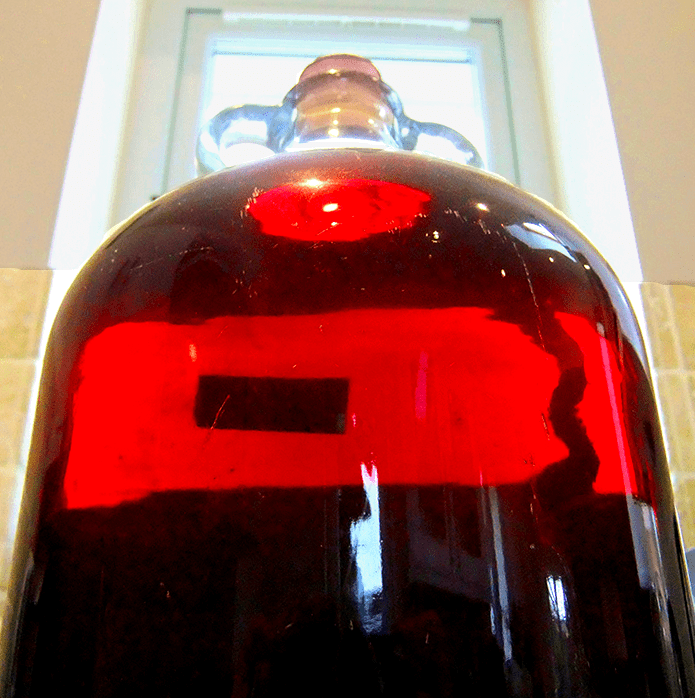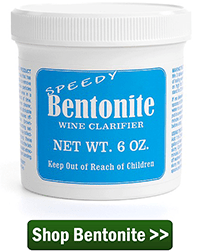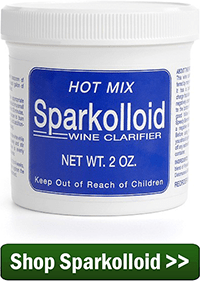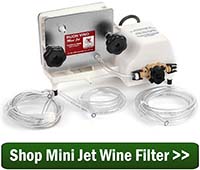 Please give me any advise on clearing wine. I have a Red wine not clearing?
Please give me any advise on clearing wine. I have a Red wine not clearing?
Name: Bruce K.
State: CA
—–
We get asked this quite often: how do you clear a cloudy homemade wine? Clearing wine can be a big concern for the first-time winemaker, especially after they see just how cloudy a homemade wine gets right after fermentation – not to worry, though.
If given enough time, it is most likely that the cloudy wine will clear up and stabilize completely on its own. Gravity will take over and eventually everything will settle to the bottom as a deposit. But there are still some things you can do to speed things along and make sure it happens and to avoid any wine clearing problems.
If the wine has just completed its fermentation, it is typical to add a dose of bentonite. This is a wine clearing agent, also referred to as a fining agent. Adding bentonite to a wine will help the proteins in the wine (including yeast) to clump together and drop to the bottom more readily. After a few days you can then rack the wine off all the sediment.
Most winemakers would stop at clearing wine with bentonite, but if you wished you could also add Sparkolloid. This is another wine clearing agent. It was designed to compliment the bentonite. While bentonite will collect and drop negatively charged particles, Sparkolloid will collect and drop out positively charged particles. Again, you would wait until the sediment stops accumulating and stabilize, then rack the wine off of it.
One could then follow up by treating the wine with a polish fining agent before bottling. This could be something like isinglass, Kitosol 40 or gelatin. Either of these will add a brilliant clarity to the wine. Just like the others, it works by dropping sediment out of the wine, so racking will be necessary before bottling the wine.
Beyond these things you could use filtration for clearing wine. There are filtration systems specifically designed for filtering the finest of particles from a wine. So fine, that you can not see them with the naked eye.
These wine filters are not at all effective in clearing a cloudy-looking wine. They work so good that the filters would clog very quickly. The wine needs to look clear before filtering it. That’s what you can use the bentonite or other wine clearing agent for.
What wine filters are good at is adding a luster to the wine that can at times bring astonishing beauty to the wine. A wine filter can take a perfectly clear looking wine and make it look like a solid hunk of glass in the wine bottle.
Now that you know all these ways you can clear a cloudy homemade wine, here’s the bad news: it is possible to over-treat a wine. In fact, if you did all the things mention above to the same wine, the wine would suffer. It would lose more body and color than necessary. The character of the wine would be diminished, leaving you with a flatter, more uneventful wine.
So, how do you clear a cloudy homemade wine without ruining it? Treatment for clear wine must be used in moderation and with a plan.
 As mentioned earlier, you could do nothing. Just wait and see if the wine will clear up sufficiently on its own. Most of the time it will clear to some successful degree and stabilize.
As mentioned earlier, you could do nothing. Just wait and see if the wine will clear up sufficiently on its own. Most of the time it will clear to some successful degree and stabilize.
- You could do everything possible to make sure you have the clearest, most beautiful wine possible, but nothing you can really enjoy.
- Or you could do what most winemakers do and hit a happy-medium. Many wine makers are happy with clear their wine with bentonite and be done with it. Another typical course of action would be something like clearing the wine with bentonite after fermentation. Then clearing the wine with gelatin before bottling. Or one might: bentonite after fermentation; then filtration, then bottle. Or, bentonite, Sparkolloid, bottle.
As you might be starting to see there are many possible answers to the question: how do you clear a cloudy homemade wine? Any of the courses of action in number 3 above, will get you a wine that is not cloudy, but what is the best way for you is something you’ll need to figure out. There is some art to clearing wine. You need to be able to know when to hold back, and you need to be able to choose with method is right for you situation at hand.
Bruce, to answer you question more directly, since you are indicating that the wine is having problems clearing, I would start by treating the wine with bentonite. If the wine does not clear, then I would try Sparkolloid. At minimum, one of these two wine clearing agents should show improvement. After that you will need to decide if you want to stop there, or possibly treat the wine with gelatin before bottling or maybe even filter the wine. The choice is yours.
Happy Winemaking!

Your information, is always helpful and greatly appreciated. I tried to crush grapes from Missouri and everything was fine until I couldn’t get rid of sediment. I was making a Vita Lambrusca, which was good but ugly. I hope to start ordering kits from you as they are easier and the results are much better. Thanks for being here………
Truman, thank you for such kind words. If there is anyway we can help you, please let us know.
If I might insert my opinion just a little here! I believe that many of the winemakers (new for the most part) are just in too much of a hurry to get the wine bottled. Winemaking is a time-sensitive journey. I have read of some winemakers keeping the wine(Red) in storage for a couple of years before bottling. Time is what makes the wine great. If anyone wants a QUICK WINE to make and drink, they should get a kit since it only takes about 30 days to bottle. But, remember all that work that was put into it so that it would be easier for you to do it. It would be much more satisfying to say that YOU made this wine and put the hard work into it. I am not coming down on you for anything, I just wanted you to know that hard work pays off in the end when you put the work into it. I know I wouldn’t do it any other way. By the way, I do make kits as well, but prefer the old ways.
I have a different problem and hope you some ideas.
I made 2 batches of grape wine from our own grapes. One turned out (that one I fermented before juicing). The other (I juiced the grapes first) and I can’t get it to ferment. I used 5 different kinds of yeast…5 different times. SG stays the same.
Cheryl
Cheryl, there are a number of different reasons that can cause a stuck fermentation. Before you can fix the situation, you need to determine the cause. The article posted below will go over the most commons reasons.
Top Reasons For Fermentation Failure
http://www.eckraus.com/wine-making-failure
You forget that CO2 needs to be removed. That Will help clearing and also help the clearing agent.
I only use kieselsol for red wine, gelatine etc with strip some flavor.
Is there a reason you siggested using Bentonite first and Sparkolloid second to clear wine?
Bill, bentonite takes the most particulate out of the wine, so that is why it is used first. The article posted below will discuss this in more detail.
When To Add Sparkolloid
http://www.eckraus.com/blog/when-to-add-sparkolloid-to-wine
after fermentation do you remove the air lock whilst clearing
Fiona, you will leave that airlock attached while the wine is clearing.
I’ve had Niagara complete and resting in glass for 10 months now. It will not clear. I’ve used a 2 part fining, didn’t work. Filtered it, didn’t work. Waited 3 months and filtered again, still dark and cloudy. Used sparkloid and bentonite 3 months ago, still cloudy. I started this from whole juice in Oct 2016 and it still looks like a cloudy American Pale Ale. Should I just give up and blend it with a darker red wine?
Trev, There are several reasons that can cause a wine not to clear. Form what you say I am assuming that you did verify with a hydrometer that the fermentation did complete. The cloudiness could be from a pectin haze or tannin falling out of the wine. The article posted below will discuss this as well as how to treat the wine once you diagnose the problem.
Reasons Your Wine Is Cloudy
http://blog.eckraus.com/cloudy-wine
I have 2 demijohns of cab/ zin mix. We usually let the wine sit for 6 months with no additives and let the wine clear naturally. This is it’s not happening. We transferred once and it’s still not clearing up. I have a 27 gallons I’m in fear of loosing this year. What do you suggest?
Ray, the first thing you need to do is find out why the wine is still cloudy.There are several reasons that can cause a cloudy wine. One of the most common is that the fermentation did not complete. The article posted below will go over what can cause a cloudy wine to occur as well as how to treat the wine.
Reasons For A Cloudy Wine
http://blog.eckraus.com/cloudy-wine
I made elderflower wine
after the first racking it remains cloudy. My english mother who has been making great country wines for decades says ” mash a few ripe bananas up in a pint of boiling water , boil well then strain , add the liquid to the wine -and put in a cool dark place for a few months , it will clear
I’ve drunk her beautifully clear elderflower and other wines for years
do any of you know of this or have an explanation or comments about this clearing technique?
Judith, the first thing that I would ask is if you have taken a hydrometer reading to verify that the fermentation is complete. The wine will not begin to clear until fermentation completes. If the fermentation is complete and the wine still will not clear, the article posted below will discuss reasons why this could be occurring.
Reasons For A Cloudy Wine
https://blog.eckraus.com/cloudy-wine
I used 2 part findings wrong way round!! Can I still clear the wine?
Martin, even if you put packet 2 in first, it should still clear the wine.
If using dualfine to clear white wine, should it be added before or after stabilization?
Wayne, i would recommend adding the clearing agent before stabilization.
I have a wine with cherry , pomegranate, cranberry and prune nectar in it
It is almost done fermentation but is extremely cloudy
Any suggestions for clearing?
Keith, if it is still fermenting it is normal for it to be cloudy. Typically it will not start to clear until the fermentation is complete.
After fermentation my Mulberry wine is pretty clear. It’s only three gallons. Would putting the carboy in a refrigerator have positive effects on clarity?
Don, what you are referring to is cold stabilization and this process does benefit the wine. It will help the falling out of wine yeast cells and other suspended proteins. It also causes any excess acids in the wine to form into crystals and fall out. This is known as acid precipitation. For more information, please see the article link posted below.
Cold Stabilization
https://blog.eckraus.com/what-is-cold-stabilization-in-wine-making
I have Niagara juice that I stabilized with Sparkolloid then comd stabilized in refridgerator, like I do with all my wine juice. But the Niagara will not settle. After a few days in the refridgerator, I removed it and added more Sparkolloid since it still wasn’t doing anything. And moved it to a place that was around 50 degrees. Why won’t it settle and clear. Thanks
Jean, there are several reasons that can cause a wine not to clear. If you have verified with a hydrometer that the fermentation is in fact complete, please take a look at the article posted below on other reasons that can cause this to occur.
Reasons For A Cloudy Wine
https://blog.eckraus.com/cloudy-wine
I stuck a bottle of white wine in the freezer to chill it and forgot about it. It turned to slush. I left it in the bottle to thaw for a day. After it thawed, all the sediment that I couldn’t even see before was sitting on the bottom and it was a lot more clear than the other ones which were already pretty clear. Why does this happen and how does it affect the wine?
Johnny, here is an article that will answer this perfectly:
What Is Cold Stabilization?
https://blog.eckraus.com/what-is-cold-stabilization-in-wine-making
I brought a wine making kit from Wilkinson’s which was good quality I have since brought a tub of red wine concentrate also from Wilkinson’s makes 30 bottles which seems ok but I have got down to bottling up and I have bottled 17 bottles and have left rest in demi John’s 1 demi John has cleared lovely the other is still very cloudy what can I do to make it clear
Bought 2 brewing cans from wilko cabernet sauvignon have made them before had put them to brew on 24th May 2020 topped up 3 days later all seemed well bubbling away when looking at them one is a lovely plum red the other a dirty brown any ideas why different colours and would it be safe to drink when finished thanks trev
Trevor, if wine wine develops a brown or orange color, this is normally an indication that the wine has oxidized. Unfortunately, you cannot reverse the effects of oxidation. Oxidation normally occurs when excessive oxygen is allowed to reach the wine. For more information, please take a look at the article posted below.
Oxidation In Wine
https://blog.eckraus.com/controlling-oxidation-making-wine
Hi there, if I add bentonite to the wine does it have to be dissolved or do I add it directly into the wine out of the package?
Thank you in advance,
Steve
Steve, to use bentonite as a clearing agent, you will make a slurry before adding it to the wine. The product should come with directions. We have also posted the directions for using bentonite below.
Directions For Speedy Bentonite
https://eckraus.com/directions-speedy-bentonite/
I can’t tell you how much my family and friends appreciate the information. I have used several of your recipes and they are always on point! You guys are tip of the spear!
Help please!
During lockdown I have been making wine from a kit from a local shop – some of it is very nice indeed.However I’ve started to get cocky and I have just bottled my wine after it had fermented and washed out the demi john when I realised I had forgotten to add the finings and stabliser!
I poured the wine back into the clean demi-john and added the finings and stabliser. Was this right or wrong?What can I do please?
Please help!
Before lock down I bought some wine making kits which can produce some really nice wine, but the last batch I made I got too cocky and bottled the wine before adding the finings and stabiliser. Once i realised my error, I poured the wine back into the cleaned demi-john. Will this work (don’t think so as I believe you need yeast) what can i do? Any suggestions appreciated – thank you